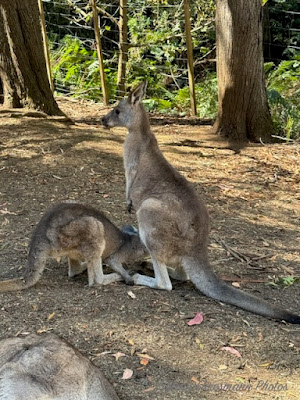One of my goals on this cruise was to see the wildlife native to these two countries. A trip to Wings Wildlife Farm helped to meet that goal. (Eden, Tasmania)
We only had an hour to see the many animals housed in the park, so we did not see everything. And not all the animals were native to Australia (& Tasmania) or New Zealand.
Echidna
about the size of a football, native to Australia
known as spiny anteaters, related to the platypus
both animals are monotremes or egg laying mammals
Meerkats
omnivores living in mobs, clans, or gangs of 20-30 in the wild in the desert of southern Africa
Common Marmoset
active tree inhibitors of the rainforests in Brazil, also omnivores
Tasmanian Devil
only surviving carnivore marsupial
has a keen sense of smell and a pungent odor
nocturnal hunter with powerful jaws to tear meat and crush bones
once inhabited Australia, now only found in Tasmania
I read they got their name from early European settlers who saw the red ears of the animal and heard the disturbing screech at night while sitting around camp fires calling them Tasmanian Devil.
Wombat
largest burrowing mammal, related to the koala
an herbivore and a marsupial, also nocturnal & native to Tasmania
Bennetts Wallaby
based on their coloring and white strip on the lip, wallaby and not grey kangaroo
native to Australia and New Zealand, eating herbs and grasses in late afternoon and at dusk
lunch time
Southern Brown Bandicoot
native to Australia and Tasmania
nocturnal omnivore about the size of a house cat
Eastern Quoll
extinct in Australia, but common in Tasmania
size of a house cat, nocturnal carnivore
Koala
native to Australia, another nocturnal marsupial
sleep 18-20 hours a day because it takes a lot of energy to digest
their fibrous, low nutrition diet of leaves
have 5 digits on their paws
Capybara
semi-aquatic rodent native to South America
carnivores, eating their own feces because the grasses are hard to digest,
but full of protein
Naked Neck Chicken
why it was on display in an incubator at Wings Park, I do not know
I included it because I had not ever heard of the Transylvania
Naked Neck Chicken or Turken
they are common in South America
Laughing Kookaburra
native to Australia and introduced to Tasmania
largest member of the Kingfisher family
carnivores
Are you singing the song yet?
Kookaburra sits in the ol' gum tree...
leaving Wings Wildlife Park
















No comments:
Post a Comment
Thanks for your comments!